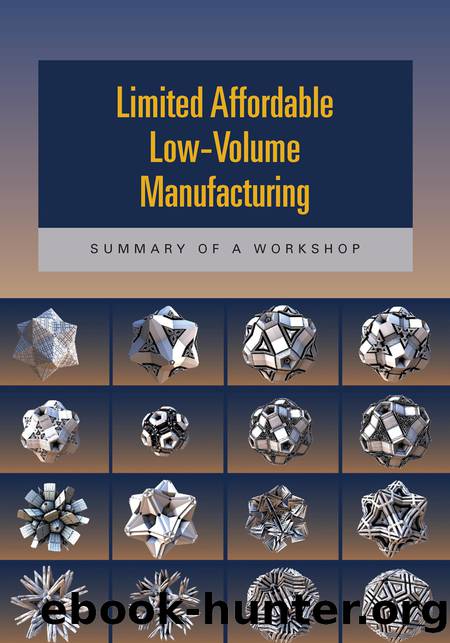Limited Affordable Low-Volume Manufacturing: Summary of a Workshop by Maureen Mellody

Author:Maureen Mellody
Language: eng
Format: epub
Publisher: The National Academies Press
Published: 2015-03-14T00:00:00+00:00
REDUCING TOTAL LEAD TIME WITH QUICK RESPONSE MANUFACTURING
Bill Ritchie, President, Tempus Institute
Mr. Ritchie began his talk by describing his own history in the manufacturing industry and how production volume has varied through his career. He illustrated the differences between the high- and low-volume markets. Mr. Ritchie began his career manufacturing 48,000 struts per day for General Motors. He then moved to making custom one-offs for truck bodies and dumpster collectors, with 4,000 customers a year. He then produced engineered-to-order pumps and water-blasting equipment. He then moved to developing custom gears. He pointed out that he knows from personal experience that high-volume manufacturing techniques do not apply to one-off production. His talk focused on quick-response manufacturing (QRM) and its applicability to low-volume manufacturing, and he recommended two seminal books on QRM, written by Rajan Suri, a professor at the University of Wisconsin (Suri, 1998, 2010).
Mr. Ritchie then described the Center for Quick Response Manufacturing at the University of Wisconsin, with which he is affiliated. The center was founded in 1993 as a university-industry partnership to address methods for lead time reduction in manufacturing. The Center has over 200 member companies, including many international companies.
Mr. Ritchie explained that there are two types of variability in manufacturing: dysfunctional and strategic. Dysfunctional variability means that something went wrong, and it includes things such as redesigns, âhotâ jobs requiring expediting, machine breakdowns, and wrong specs. Strategic variability is the result of changes in circumstances, and it includes such things as increased product options, custom-engineered products, and highly variable demand. Traditional manufacturing techniques seek to reduce variability, no matter the source. The purpose of QRM is to exploit strategic variation in addition to resolving dysfunctional variation. The overall goal is to reduce total lead time. When total lead time is reduced, other benefits are realized, such as improved quality and decreased costs. Mr. Ritchie gave an example of a company that reduced manufacturing lead time from 75 to 4 days, lowering the cost per part by 30 percent. In another example using QRM, lead times were lowered from 47 hours to 1 hour by reducing premanufacturing (i.e., administrative) lead time. Mr. Ritchie provided additional examples of total lead time reduction that lowered cost and increased profit.
Mr. Ritchie broke down QRM into four core concepts and described each one in more detail:
Understand the power of time. Mr. Ritchie said that lead time drives everything: business understanding, decisions, and metrics. He pointed out that in most cases the touch time (the amount of time actually working with the product) is but a fraction of the overall elapsed time in a manufacturing project. This provides the opportunity to dramatically reduce the overall elapsed time by reducing the lead times at each step of the project. Figure 2 shows the time breakdown for an example manufacturing process. In the example, the office lead time was 12.6 days, during which only 1 hour of work was performed. Mr. Ritchie pointed out that most companies focus on improving touch-time efficiencyâthe direct labor portionâwhereas the real saving to be gained is in total lead time.
Download
This site does not store any files on its server. We only index and link to content provided by other sites. Please contact the content providers to delete copyright contents if any and email us, we'll remove relevant links or contents immediately.
Whiskies Galore by Ian Buxton(41885)
Introduction to Aircraft Design (Cambridge Aerospace Series) by John P. Fielding(33064)
Small Unmanned Fixed-wing Aircraft Design by Andrew J. Keane Andras Sobester James P. Scanlan & András Sóbester & James P. Scanlan(32744)
Aircraft Design of WWII: A Sketchbook by Lockheed Aircraft Corporation(32218)
Craft Beer for the Homebrewer by Michael Agnew(18145)
Turbulence by E. J. Noyes(7942)
The Complete Stick Figure Physics Tutorials by Allen Sarah(7312)
The Institute by Stephen King(6947)
Kaplan MCAT General Chemistry Review by Kaplan(6868)
The Thirst by Nesbo Jo(6832)
Bad Blood by John Carreyrou(6558)
Modelling of Convective Heat and Mass Transfer in Rotating Flows by Igor V. Shevchuk(6392)
Learning SQL by Alan Beaulieu(6213)
Weapons of Math Destruction by Cathy O'Neil(6152)
Man-made Catastrophes and Risk Information Concealment by Dmitry Chernov & Didier Sornette(5926)
Permanent Record by Edward Snowden(5743)
Digital Minimalism by Cal Newport;(5667)
Life 3.0: Being Human in the Age of Artificial Intelligence by Tegmark Max(5478)
iGen by Jean M. Twenge(5367)
